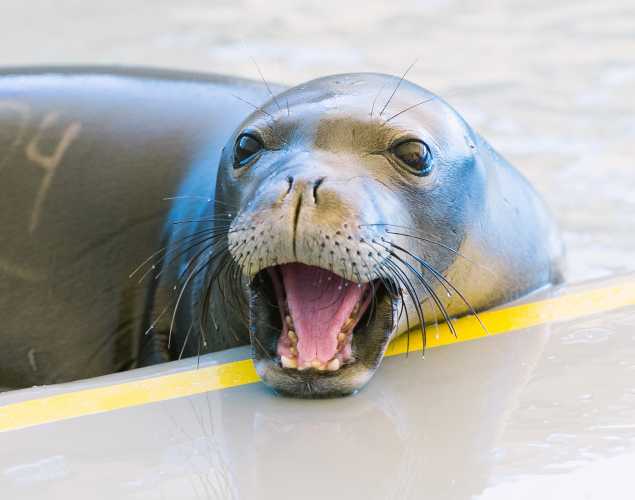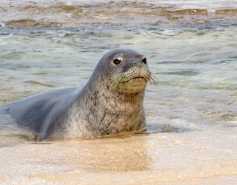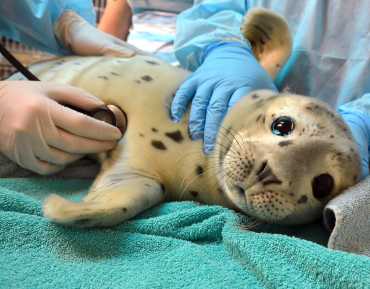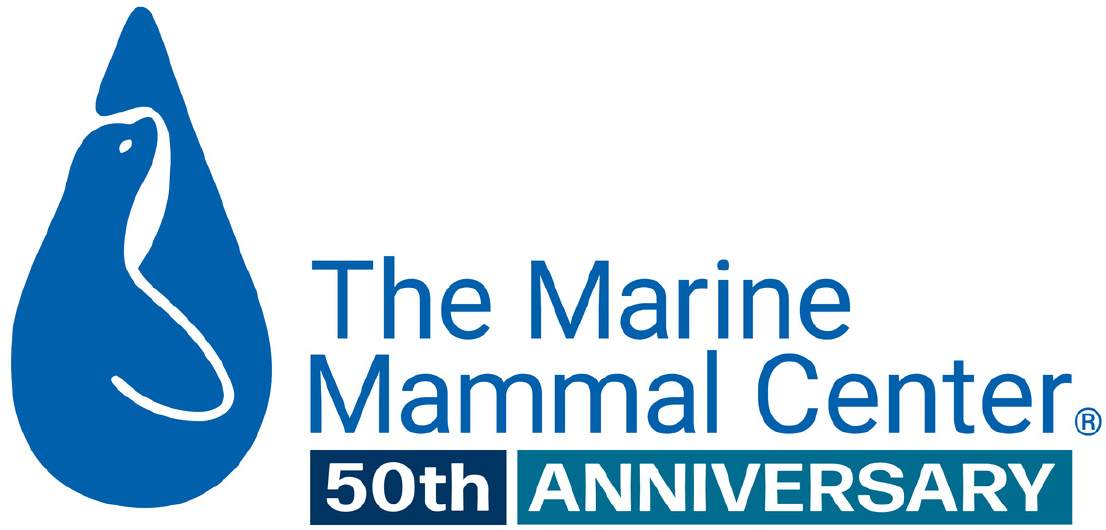
Malnourished Hawaiian Monk Seals Rescued from Northwestern Hawaiian Islands
- Species conservation
Two recently weaned monk seal pups brought to Ke Kai Ola are now receiving rehabilitative care, while two other monk seal patients are on the cusp of release.
Two endangered Hawaiian monk seals recently arrived at Ke Kai Ola, The Marine Mammal Center’s hospital in Kailua-Kona, Hawai‘i. The two new patients are weaned pups from Laysan Island in the Northwestern Hawaiian Islands that were suffering from malnourishment.
The young female is named Maiapilo, which is a hardy, drought- and heat-resistant plant native to Laysan with a beautiful, fragrant flower. The young male is named ‘Ākulikuli, which is a low-crawling plant that loves the beach area. ‘Ākulikuli was about 24 pounds lighter than his companion and had a few lacerations on his face and a small ulcer on the roof of his mouth, but like Maiapilo, is active and otherwise doing well.
Hurricane Olivia delayed the seals’ trip to our hospital. The NOAA research vessel Oscar Elton Sette that had rescued the seals in the Northwestern Hawaiian Islands had to go into port at Pearl Harbor to seek shelter as the hurricane approached the islands.
But the patients were never in danger as the ship was the safest place for them to weather the storm. Animal Care Manager Megan McGinnis was onboard the ship and ensured that Maiapilo and ‘Ākulikuli started receiving treatment before they even reached our hospital.
While on the ship, Maiapilo was given a de-worming treatment to remove her parasites, and ‘Ākulikuli received antibiotics for his mouth ulcer. Three times a day, they both received fish-mash smoothies to help them get the vital nutrients they need to regain their health.
“As the young seals grew stronger, their individual personalities started to shine through, even on the ship,” says McGinnis. “‘Ākulikuli is small but vocal, while Maiapilo has been feisty from the start!”
Once the storm had passed, Maiapilo, ‘Ākulikuli, and the accompanying researchers and caretakers set sail toward the Big Island.
Learn More About Hawaiian Monk Seals
Sign up to receive Hawaiian monk seal news, patient updates and more straight to your inbox.
{"image":"\/Animals\/Wild\/Hawaiian monk seal\/hawaiian-monk-seal-shutterstock.jpg","alt":"Hawaiian monk seal at the shoreline","label":"Pinnipeds","title":"Hawaiian Monk Seal","link_url":"\/animal-care\/learn-about-marine-mammals\/pinnipeds\/hawaiian-monk-seal","type":"page"}

{"image":"\/Animals\/Wild\/Hawaiian monk seal\/cropped-images\/HMS-wild-NOAA-4-832-3197-1474-1603733454.jpg","alt":"Two Hawaiian monk seals sleeping on the beach.","label":"Conservation","title":"Hawaiian Monk Seal Conservation","link_url":"\/science-conservation\/conservation\/hawaiian-monk-seal-conservation","type":"page"}

{"image":"\/Animals\/Patients\/Hawaiian monk seals\/2015\/hms-pearl-by-julie-steelman-c-the-marine-mammal-center-noaa-permit-18786.jpg","alt":"Hawaiian monk seal Pearl","title":"Understanding Endangered","link_url":"https:\/\/www.marinemammalcenter.org\/publications\/understanding-endangered","label":"Online Learning Resource","type":"publication"}

{"image":"\/Animals\/Patients\/Hawaiian monk seals\/2016\/hms-nihoole-5-photo-c-noaa-permit-16632.jpg","alt":"Hawaiian monk seal Niho'ole","title":"Aloha \u02bb\u0100ina","link_url":"https:\/\/www.marinemammalcenter.org\/publications\/aloha-aina","label":"Online Learning Resource","type":"publication"}

Upon arrival to Ke Kai Ola, Maiapilo and ‘Ākulikuli joined two young patients already there – Sole and RK58. You may remember these two pups arrived at Ke Kai Ola earlier in the summer after being involved in mom-pup pair switches that left them orphaned and unable to get the nutrition they needed to survive.
Sole is currently free-feeding fish, a clear and reassuring sign he has learned how to be a wild Hawaiian monk seal! RK58 is not quite at that stage yet, but our animal care experts say that he is “oh-so-close.” They expect that Sole and RK58 will be ready for release soon!
Researchers aboard the Oscar Elton Sette added more good news: a former patient, Meleana, was resighted looking healthy and at home among the 1,200-mile archipelago of small islands and atolls known as the Northwestern Hawaiian Islands. She was admitted to Ke Kai Ola in 2014 for being prematurely weaned and weighing half of what she should have weighed – an unfortunate but common fate for monk seal pups.
The resight is significant because it demonstrates the long-term impact of our work to save this species. Since opening the hospital in 2014, The Marine Mammal Center’s veterinary experts have successfully rehabilitated nearly two percent of this endangered population, returning 23 healthy monk seals to the wild with four more now in our care.
Researchers estimate the current monk seal population to be about 1,400 animals, and about 30 percent of those monk seals are alive today directly due to conservation efforts. Young seals are the most vulnerable animals in the population, with relatively few surviving to adulthood. Pups and juvenile seals in the Northwestern Hawaiian Islands often fall victim to threats like entanglement in ocean trash, changes in the food chain and predation.
Hawaiian monk seals are also highly sensitive to climate change impacts. Sea-level rise and increased coastal erosion will reduce the haul-out sites they depend on, and may increase shark predation. Increasing sea surface temperatures will limit available prey for marine mammals just as it has on the West Coast of the United States.
Maiapilo and ‘Ākulikuli will stay at Ke Kai Ola while they gain strength before returning to the Northwestern Hawaiian Islands where they were rescued.
As these seals mature and have pups of their own, monk seal experts hope this will improve the species’ chances of survival in the islands that have been their home for millions of years. The Marine Mammal Center's team also monitors Hawaiian monk seal haul out activity on the island of Hawai‘i and manages rescue efforts for sick and injured seals reported to the hospital’s hotline (808-987-0765).
Header image: Photo by Elena Graham © The Marine Mammal Center / NOAA permit #18786
Yes, I want to save a life!

Yes, I want to save a life!
You’ll be giving sick and injured animals the best possible care at the Center’s state-of-the-art hospital. With your gift today, you are giving a patient a second chance at life in the wild.
See Our Latest News
{"image":"\/Animals\/Patients\/Hawaiian monk seals\/2025\/cropped-images\/d-ru28release-exam-at-ke-kai-ola111025photo-by-giancarlo-rulli-c-the-marine-mammal-center-noaa-permit-24359-0-0-1270-992-1764620886.jpg","alt":"","title":"Bird Flu Vaccine Trial Offers Hope for Protecting Hawaiian Monk Seals","link_url":"https:\/\/www.marinemammalcenter.org\/news\/bird-flu-vaccine-trial-may-offer-hope-for-protecting-hawaiian-monk-seals","label":"News Update","date":"2025-12-01 08:13:00"}

Bird Flu Vaccine Trial Offers Hope for Protecting Hawaiian Monk Seals
December 1, 2025
Read More{"image":"\/Animals\/Patients\/Hawaiian monk seals\/2021\/hms-pp08-by-sheila-latta-c-the-marine-mammal-center-noaa-permit-18786.jpg","alt":"Hawaiian monk seal","title":"The New York Times: Inside the Bird-Flu Vaccine Trial for Monk Seals","link_url":"https:\/\/www.marinemammalcenter.org\/news\/the-new-york-times-inside-the-bird-flu-vaccine-trial-for-monk-seals","label":"In the News","date":"2025-12-01 01:00:00"}

The New York Times: Inside the Bird-Flu Vaccine Trial for Monk Seals
December 1, 2025
Read More{"image":"\/Animals\/Wild\/Sea otter\/so-wild-morro-bayphoto-c-brian-simuro-20.jpeg","alt":"Sea otter and pup","title":"Watch a Sea Otter Pup Reunite With Its Mother","link_url":"https:\/\/www.marinemammalcenter.org\/news\/watch-sea-otter-pup-reunite-with-its-mother","label":"News Update","date":"2025-11-14 10:35:41"}

{"image":"\/Animals\/Wild\/Sea otter\/sea-otter-photo-c-brian-simuro.jpeg","alt":"Sea otter","title":"AP News: Baby sea otter is reunited with mother in central California after dramatic rescue","link_url":"https:\/\/www.marinemammalcenter.org\/news\/ap-news-baby-sea-otter-is-reunited-with-mother-in-central-california-after-dramatic-rescue","label":"In the News","date":"2025-11-14 09:46:34"}

AP News: Baby sea otter is reunited with mother in central California after dramatic rescue
November 14, 2025
Read MoreMegan McGinnis
Hawaiian Monk Seal
